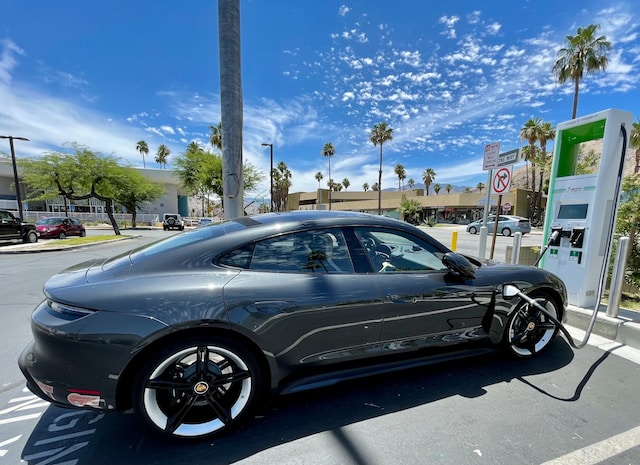Contents
- 1 Introduction
- 2 Electric cars have been around for many years, but they never reached mainstream popularity.
- 3 Governments worldwide are mandating quotas for electric cars to be produced and sold.
- 4 Tesla expects its Model 3 to be profitable.
- 5 Range anxiety is still a major concern in the electric car industry.
- 6 Manufacturers have had to make drastic improvements in battery life and charging time to meet consumer needs.
- 7 Tesla has pushed the industry forward with their new Supercharger technology.
- 8 The future of electric vehicles is bright.
- 9 Electric cars are here to stay and will continue to grow in popularity with new innovations being made every day
- 10 Conclusion
Introduction
Electric cars have been around for many years, but they never reached mainstream popularity. Governments worldwide are mandating quotas for electric cars to be produced and sold. Tesla expects its Model 3 to be profitable. Range anxiety is still a major concern in the electric car industry. Manufacturers have had to make drastic improvements in battery life and charging time to meet consumer needs. Tesla has pushed the industry forward with their new Supercharger technology. The future of electric vehicles is bright
Electric cars have been around for many years, but they never reached mainstream popularity.
In fact, the first electric car was invented in the early 1900s by a Scottish engineer named Alexander Anderson and sold under the name Electrobat. At that time there were almost no roads in America and most people didn’t have access to electricity at home, so these vehicles were mainly used as taxis in big cities like New York or Chicago where they could be recharged at night while parked on city streets (a practice known as “tethered” charging).
In addition to being expensive due to their high battery costs compared with internal combustion engines (ICE), early electric vehicles had several other drawbacks: They could only go about 30 miles on a single charge and took hours or even days before they could be fully charged again; their batteries were heavy; they couldn’t go very fast–around 40 mph tops–and had limited range because of this problem; plus their engines made loud noises that bothered pedestrians when driving past them on sidewalks outside stores during rush hour traffic jams caused by overcrowding due largely because too many people owned cars instead of public transportation options like buses or trains.”
Governments worldwide are mandating quotas for electric cars to be produced and sold.
This is the result of several factors, including the need to reduce carbon dioxide emissions, lower costs for consumers, and improve efficiency. The main reason behind this trend is that producing an electric vehicle is cheaper than producing a conventional model because it does not require gasoline or diesel fuel.
The cost savings associated with manufacturing an EV can be significant: one study found that building an EV costs about $2,500 less per unit than creating an internal combustion engine (ICE) car–and that’s before factoring in any subsidies or tax credits offered by governments. In addition, maintenance costs are lower because there are fewer parts involved in running an electric vehicle; this means less labor time spent repairing them after accidents or other damage occurs on the roadways where they travel regularly throughout their lifetimes!
Tesla expects its Model 3 to be profitable.
The Model 3 is a cheaper alternative to the Model S and Model X, but it still comes with all of Tesla’s bells and whistles: self-driving capabilities, a large touchscreen display and fast charging capabilities.
The base model will start at $35k for a battery range of 220 miles (354 kilometers), while the long range model starts at $44k for 310 miles (500 kilometers). Tesla CEO Elon Musk has said that he expects production of these vehicles to begin in July 2018 and scale up from there as they ramp up production throughout 2019.
Range anxiety is still a major concern in the electric car industry.
It’s a concern for consumers, manufacturers and governments, who want to see more electric vehicles on the road in order to reduce emissions and fight climate change. It’s also something that charging infrastructure providers are working hard to alleviate with new technologies like Ionity — Europe’s first ultra-fast charging network — as well as Tesla’s new Supercharger V3 stations that promise up to 350 kW of power (up from 120 kW). But what about battery manufacturers? What role do they play in all this?
According to GM’s Bolt EV Chief Engineer Josh Tavel: “The goal is always going be zero emission vehicles…Batteries have been getting better every year…We have seen them go from 1 kWh per kilogram down into low hundreds now.”
Manufacturers have had to make drastic improvements in battery life and charging time to meet consumer needs.
Battery life is still the biggest obstacle to mass adoption of electric vehicles. Though battery technology has improved, it is not good enough for long distance travel. Charging time is another issue; it takes hours to charge a car and many people simply don’t have the time or patience for that.
However, there are some solutions available today that may help solve these problems in the future:
Tesla has pushed the industry forward with their new Supercharger technology.
Tesla’s proprietary charging system consists of high-power wall connectors and a network of DC fast-charging stations for Tesla vehicles. The company’s first station opened in 2012, but since then it has expanded rapidly across North America and Europe, with over 10,000 individual units installed worldwide.
Tesla’s Superchargers can charge Model S and Model X at a rate of up to 120 kWh per hour–almost twice as fast as any other DC fast charger on the market today–and Model 3 at an even faster rate (up to 145 kWh/hr). They are located every 200 miles along major interstates so drivers can make long distance trips without having to stop at conventional gas stations for refueling stops.*
The future of electric vehicles is bright.
- Electric cars are becoming more popular, with sales increasing by over 50% in 2018.
- Electric cars are more environmentally friendly than their gas-powered counterparts because they don’t emit CO2 into the atmosphere and use less electricity from fossil fuels to charge themselves up.
- They’re also more efficient–they can travel further on a single charge than a conventional vehicle can on a tank of gas, which means less money spent at the pump (and fewer greenhouse gases released into our shared environment).
Electric cars are here to stay and will continue to grow in popularity with new innovations being made every day
The government is supporting electric cars, as well as the private sector by making sure that the technology keeps improving. Improvements in battery life and charging time have been made recently, which means that you can now drive your electric car further than you could before on one charge of your battery. New technologies like wireless charging are also being introduced, which will make charging easier than ever before!
Tesla has pushed the industry forward by making an incredibly popular mainstream model that has changed how we look at electric vehicles (EVs). Other manufacturers are following suit with their own versions of EVs now too: Chevrolet Bolt EV; Nissan Leaf 2; BMW i3 REX – these all offer different features but share common traits such as being powered entirely by electricity instead of gasoline or diesel fuel like traditional combustion engine vehicles (ICEVs).
Conclusion
It’s clear that electric cars are here to stay and will continue to grow in popularity with new innovations being made every day. There are still challenges that need to be overcome before we can see widespread adoption of these vehicles, but the future looks bright for those who want an alternative means of transportation.

